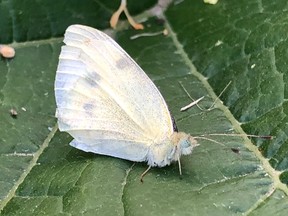Catching the problem early can not only save a plant from destruction but also make the solution much easier.

Reviews and recommendations are unbiased and products are independently selected. Postmedia may earn an affiliate commission from purchases made through links on this page.
Article content
It’s often frustrating when we work so hard to grow and care for our gardens only to have insects, disease and other pests create a number of serious problems. From spinach, swiss chard, and beet leaves spoiled by leaf miners to chewed foliage on brassicas, diseased, black-spotted roses and hydrangeas plagued by scale, we are facing a lot of trials out there.
Advertisement 2
Article content
We’re all very busy but the most important thing we can do to protect our plants is consistent preventive maintenance. Spotting a problem before it can ruin our plants is the highest priority. The single most important thing we can do is to look carefully at all the plants in our gardens at least twice a week. Catching the beginning of a problem early can not only save a plant from destruction but also make the solution much easier.
Article content
The adage, “an ounce of prevention is worth a pound of cure” is most applicable to our gardens.
The key is to watch for indications of challenges to come. As soon as we see a white cabbage butterfly moth flitting in our garden, we know very well all our brassicas are about to be chewed by their larvae. We all realize that organic or close-to-organic solutions are the best means of control, so we can cover the brassicas with Remay cloth or preventively spray each week with bacterial BTK (bacillus thuringiensis kurstaki). Either of these remedies will keep your beautiful broccoli and cauliflower clean.
Article content
Advertisement 3
Article content

A similar solution can be applied to the foliage of beets, spinach, and swiss chard. If you notice a bit of tunnelling in the leaves, or if you take a leaf and hold it up to the sun and see tiny black dots in it, be sure to pick off the affected leaves and immediately cover the crops with Remay. This will keep these tunnelling insects from getting into your foliage while still allowing the plants to grow. Don’t throw all the leaves away, just discard the infected portions and enjoy the rest.
Green, brown, and black aphids love to feed in the softer growing tips of so many plants. If, through careful observation, you catch them early you can simply wash them off with a little pressure from the garden hose. If the plants are already heavily infested, wash most of them off first, then perhaps use a Safer’s Soap product like Trounce on a regular basis to keep them in check.
Advertisement 4
Article content
With this drier weather, our roses are blooming quite nicely, but they usually have several issues to be dealt with, the most problematic being various fungal threats. Mildew, Black Spot, and rust are the most common afflictions, and here again, catching them at an early stage makes them easier to control.

Simply pick off and dispose of any infested foliage to prevent further spread. Using a weekly preventive spray like garden sulphur or even baking soda, at a rate of eight grams per litre of water, can also be effective.
In the longer term, when you plant roses in your garden, be sure to choose varieties like many of the new shrub roses which have been bred to be far more disease resistant. Plant all roses in a sunny location with good air flow to minimize problems. If you do experience issues, or they are overgrown and out of control, simply prune roses back to about one-third, remove any infected foliage, and let them re-flush with new growth. In these ideal growing conditions of summer, I find this is usually enough time to reward you with new blooms in a matter of a few weeks.
Advertisement 5
Article content
Over the past couple of years, so many folks have been plagued with scale on their hydrangeas and other plants as well. If you currently have hydrangeas, especially the mophead or macrophylla varieties, please look on the underside of the leaves and along stems to see if you have white scale. If found, snip off all the infected leaves and spray every five to seven days with organic horticultural oil at the growing season ratio.

Many of our container grown plants, both food and ornamental, have become stressed with the recent hot weather and constant watering. The solution is more feeding on a regular basis. For a faster turnaround, use either 20-20-20 soluble feed, or another I like, Alaska’s Morbloom 0-10-10. Make sure you water first before feeding to prevent burning, and if you add some slow release 14-14-14 on top of the soil, it will provide continuous feeding for three to four months each time you water.
Advertisement 6
Article content
Although we are told by some to let the lawns go brown, within the scope of current water restrictions we still need to get about one inch of water per week onto our lawns to keep them green. This helps cool the neighbourhood, it’s FireSmart, and it protects the soil micro-organisms and worms necessary for soil regeneration.
Our gardens bring untold value to us in many ways, but pests and weather issues are all challenges we should anticipate as part of the process. Being proactive, finding organic solutions, and protecting beneficial insects and birds is the very best way we can work with nature.
-

Brian Minter: Exploring the field of urban forestry
-

Brian Minter: Appreciating the diversity of perennials












Comments
Postmedia is committed to maintaining a lively but civil forum for discussion and encourage all readers to share their views on our articles. Comments may take up to an hour for moderation before appearing on the site. We ask you to keep your comments relevant and respectful. We have enabled email notifications—you will now receive an email if you receive a reply to your comment, there is an update to a comment thread you follow or if a user you follow comments. Visit our Community Guidelines for more information and details on how to adjust your email settings.
Join the Conversation